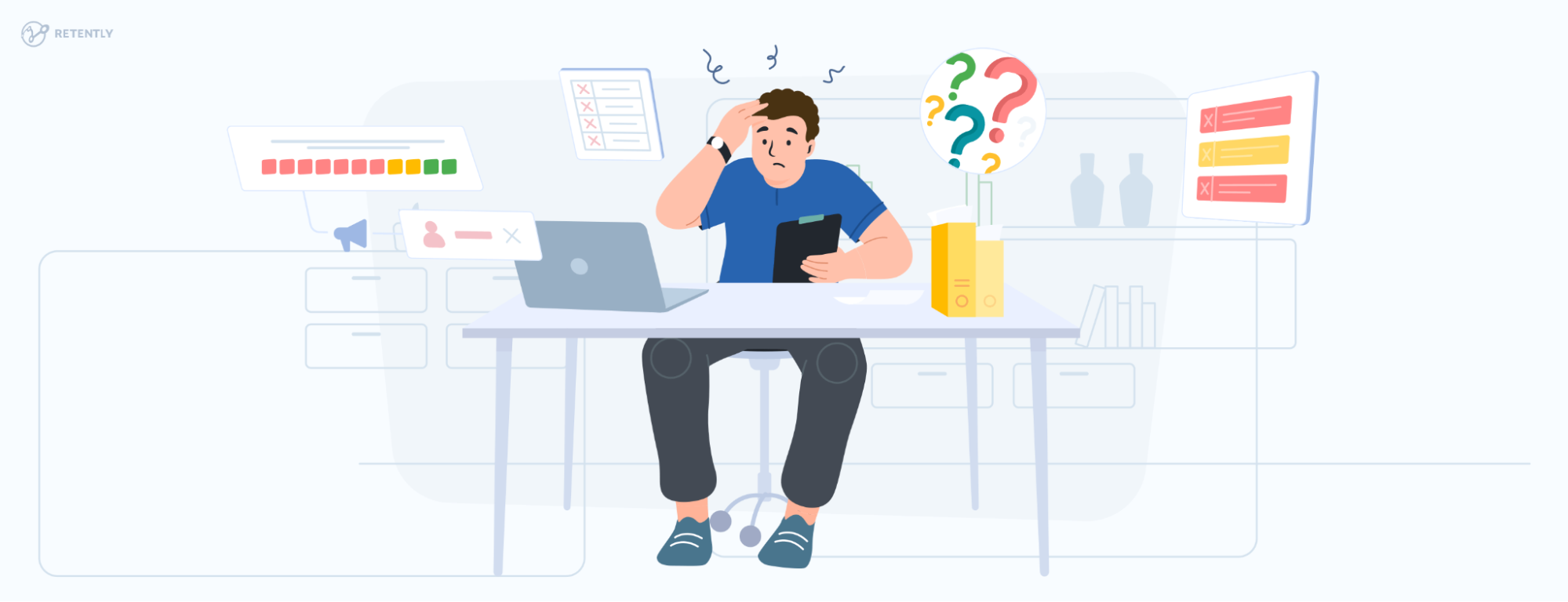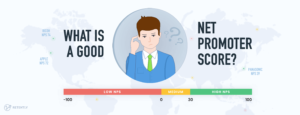While many people think of Net Promoter Score® surveys as revolving around a simple 0 to 10 rating scale, the reality is that there are two sides to NPS® — the quantitative (the rating) and the qualitative side (the feedback).
Just like few things are more frustrating for the average person than sending an email without getting a response, few things are as discouraging for a customer satisfaction expert as sending an NPS survey and receiving a score without any qualitative feedback.
Qualitative feedback, or text feedback, is part of what makes NPS such an effective strategy for measuring customer satisfaction. It provides an extra layer of insight for your business, allowing you to act on a customer’s feedback rather than simply learning their opinion.
Despite this, it’s missing from the vast majority of NPS survey data, meaning many businesses are using NPS suboptimally. While an effective NPS survey can get a 40% response rate, many of these responses are purely quantitative and lack any useful user feedback.
Sounds familiar? If you’re one of the many people using NPS software like Retently to listen to the voice of your customers, there are a variety of reasons why you may not be receiving as many textual responses as you’d like.
Below, we’ve listed some of these reasons, along with actionable tactics you can use to turn the situation around and increase the amount of qualitative feedback from your NPS survey recipients.
Your Customers Aren’t Used to Personalized Communication
If you don’t communicate with your customers via email very often, receiving a Net Promoter Score survey can come as a bit of a surprise.
As a result, many customers might be willing to take a minute or two to give your business or product a rating, but not to write out a message. The reason? Since you’ve rarely contacted them, there’s no human on the other side of the conversation for them to visualize and connect with.
Building a personal connection with your customers, whether over email or live chat, can go a long way towards improving not just the amount of qualitative feedback that you get from your NPS surveys, but your response rate as a whole.
To make your emails feel more personal, try including a short message with your NPS survey that explains why you’re getting in touch and how much a response would mean to you. Send the email from a real, human email address — not a generic “no-reply”.
For example, would you feel motivated to spend a few minutes of your time writing a detailed response to an email without a real person’s name signed to it? Personalize your NPS survey and you’ll quickly notice an increase in the number of qualitative responses you receive.
Your Customers Feel Nervous About Providing Honest Feedback
Sometimes, your customers might be willing to provide an accurate rating of their likelihood to recommend your business to their peers using the 0 to 10 scale of an NPS survey email, but not to deliver honest feedback.
The reason? They talk to members of your business on a regular basis and don’t feel comfortable giving honest, accurate feedback if it means potentially offending someone.
This is a common problem for small and mid-sized businesses that survey their clients using an NPS service. It’s especially common for service businesses, where a complaint made via email could be read by the person responsible for the problem it’s addressing.
There are several ways to deal with this issue. The first is to explain to customers that you value all feedback, whether positive or negative. Let them know that you’re comfortable reading direct and plain-spoken feedback, especially if it includes something you’re doing wrong.
The second is to reach out to customers over an alternative medium — a tactic we’ve explained in more detail below.
Lastly, you could be sending out anonymous surveys. Customers will be more open to sharing their opinions when they know nobody would see their name. Many survey software providers, including Retently, have this option available.
This problem is extremely common, especially in the world of B2B, where no one wants to come off as rude or mean towards an important supplier or partner. Luckily, it often solves itself as you and your customers develop a closer, more candid, and transparent relationship.
Your Customers Want to Talk, But Not Via Email
This reason is shaped by the one covered above — your customers want to talk, but they might not feel comfortable providing honest feedback via email.
Sometimes, the most effective way to get honest, actionable feedback from your customers on how you can improve your product, service, or business as a whole is to reach out to them the old-fashioned way: over the phone.
If you’ve received an NPS survey response from a customer who makes it clear he isn’t fully satisfied, try getting in touch with a phone call. Instead of email silence, there’s a good chance he’ll quickly tell you the reason behind his unhappiness with your product or service.
Reaching out over the phone is a particularly effective strategy for connecting with Detractors in B2B. Often, a simple phone call is all it takes to show that you value your relationship and want to double-check that everything is okay.
After you successfully get in touch with a Passive or Detractor over the phone (or through any other non-email medium, like talking at a trade show or visiting their office in person), keep an eye on their next NPS survey response — it might be significantly more positive than the last.
Your Customers Are Too New to Provide Useful Feedback
Some customers might feel comfortable answering your survey, but think they’re too “fresh” to provide useful advice to your business. This usually means you’ll get an accurate score from your NPS survey but little in the way of actionable feedback.
This happens fairly often, especially to new SaaS startups without an established base of users and paying customers. When a customer first starts using your product, their focus is often more on finding their way around and getting things set up than helping you improve.
New customers can also fail to leave feedback for the opposite reason — they signed up due to a mismatch between expectations and reality, then left once they realized your product wasn’t what they expected.
Similar to other issues, there are several ways to deal with this one as well. The first is to personalize your onboarding process (such as with a personal “welcome aboard email”) to make it clear to new customers that they’re never more than one step away from talking to actual humans.
In the age of chatbots and automated helpdesks, you’ll be surprised at how effective a simple personalized email can be.
The second is to follow up after you receive their NPS rating with an email asking for quick and simple feedback. Often, a short and amiable email from a customer success manager is all that’s needed to open and close the feedback loop with a fresh customer.
Your Customers Are Not Receiving the Right Questions
While the NPS question itself is standard, the follow-up questions are open to adjustments. This is where the misunderstanding can happen.
If you want to collect actionable qualitative feedback, make sure the wording of the question is neither too general nor confusing. It should be centered around the specific interaction or the type of experience you are looking into. Don’t just leave a text box with ‘Any comments?’ below it, as respondents will easily ignore it or give short irrelevant feedback.
Answers like you have a great product or I have problems using your product don’t provide actionable information, so rethinking questions so that they surface the required data will make a big difference. Instead of a generic why question, try asking them which features are the most useful for their scope or how you can improve their experience. This way respondents will have the option of expanding on their pain points and coming up with ideas and suggestions. If you need more inspiration, we have a thorough guide on the best NPS survey questions to go for.
And don’t forget that the follow-up questions should reflect the given score, i.e. Promoters, Passives and Detractors should get different questions that will help them reveal the specific reasons behind their NPS rating.
Your Customers Are Too Busy for Long Surveys
As a rule, it shouldn’t take more than 2-3 minutes to respond to a survey, so make sure your questionnaires are short. People are extremely busy these days, and even the most loyal customers will not spend much time answering dozens of questions.
Limit your survey to the most relevant questions only, like the NPS question itself and a couple of follow-up queries to allow respondents to explain the reasons behind the given score.
Make sure not to include multiple open-ended questions. This type of question does give the full control of the answer to the customer, not limiting it with predefined options, but overwhelming the survey with open-ended questions will not make customers particularly happy about them. The same goes for the mandatory ones: unless it is critical to get an answer, allow respondents to skip or include a N/A option.
Also, make sure to warn respondents how much time they will have to spend on the survey and be honest about it: they won’t thank you when they realize they have to spend 10 minutes when you promised they will need only 3.
Your Customers Are Tired of Receiving Surveys
Finally, like all methods of communication, NPS emails can become tiresome and ineffective if you overuse them.
Some companies become slightly addicted to NPS, treating it as a metric that can never be high enough. While it’s good for any business to have a focus on continual improvement, sending out email after email isn’t the right way to do it.
Send too many NPS surveys and you’ll notice your response rate dropping or your customers quickly giving a score without providing any feedback. The end result is less reliable data and a less effective customer satisfaction surveying process — two things you definitely don’t want.
Unfortunately, this problem is so common that we included it in our list of poor NPS practices that are best to be avoided. While it’s good to keep in touch with your customer and close the loop when you receive feedback, no business scores for being a spammer.
Worried you’re making this mistake? Our guide to NPS survey timing covers the best frequency for sending out NPS surveys in order to collect reliable, regular data without burning out your clients.
While timing is important, also consider the means you send your survey through. For some people email works better, others will be more willing to respond if they get a pop-up survey in the app or a message in social media.
What if following the above tricks, you are still short of qualitative feedback?
It is worth mentioning that the process of collecting qualitative feedback is not done once your survey is taken. Even if a customer has not provided text feedback to the NPS question, you always have the possibility to reach out with a more personalized touch thereafter to find more about the reason for the received score. Dig into customer data and their behavior over time, to make your interaction even more meaningful, increasing your chances for actionable insights.
Subconsciously people dive into examining only the low scores, Detractors in this case, as this is where the real problem with a product lies. In addition to giving a negative picture, reading through these comments is frustrating, to say the least.
While this feedback is indeed very useful, Passives and Promoters provide relevant suggestions and ideas as well, so you have to analyze the entire set of responses to come up with a holistic overview.
Start Collecting Actionable Customer Feedback With Retently
Qualitative feedback is used by many businesses to uncover customer issues and expectations – insights that can lead to product/service improvements and better decision-making.
We’ve designed Retently from the ground up to make it as easy as possible for you to survey your customers and gather useful, actionable feedback that helps you reduce your churn rate and grow your business.
To get started, sign up for your free trial and start collecting actionable feedback and calculating your business’ Net Promoter Score.

















 Alex Bitca
Alex Bitca 

 Christina Sol
Christina Sol 

 Greg Raileanu
Greg Raileanu 


